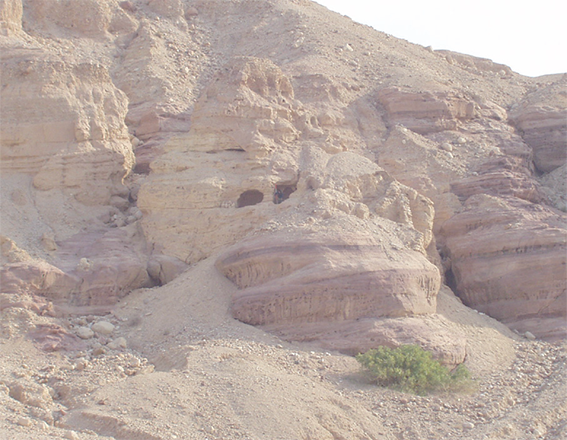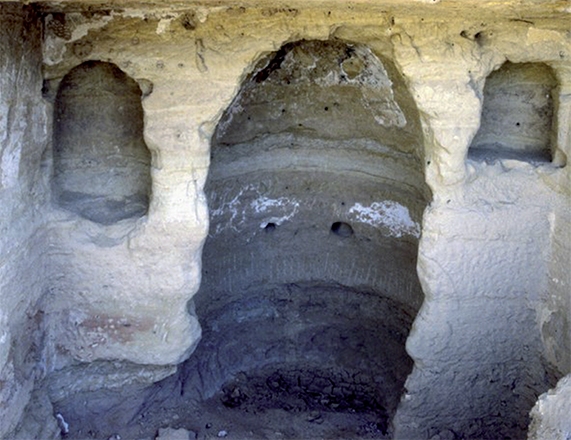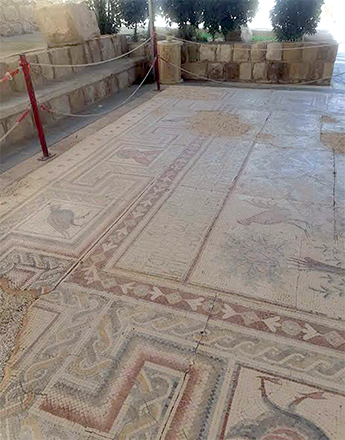You are here
Ancient hermits : Delving into monastic life in Roman-Byzantine Levant
By Saeb Rawashdeh - Apr 09,2024 - Last updated at Apr 09,2024

Caves used in Wadi Al Hasa by hermits (Photo courtesy of Konstantinos Politis)
AMMAN — Palaestina Tertia, a late Roman-Byzantine province, was well known for its monastic life. It was located in the southern part of modern Jordan, from Wadi Mujib in the north to Ayla (Aqaba) in the south. The role of the province was defensive and it was a frontier towards Arabic nomads and Sassanian Empire on the East.
The western part of Palaestina Tertia province was characterised by the network of roads, urban centres and fortifications whose role was to protect the area. The Via Nova Triana established in the heydays of the Roman Empire in the 2nd century AD connected southern Syria with Ayla, while Dead Sea and Wadi Arabah also played an important strategic role. The ancient Zoara, located on the southern tip of the Dead Sea, was an ecclesiastical and military hub where the Roman cavalry was stationed.
“Although the archaeological work in Wadi Arabah is still at initial stage other Roman-Byzantine sites like Khirbet Hassiya, Bir Madkur and Khirbet at-Tayyibah may have been military installation protecting the Tenth Legionary fort in Ayla,” said Konstantinos Politis, a Greek archaeologist, noting that forts communication went from East to West.
Living far from cities and villages, monastic communities, hermits and ascetics who inhabited caves, cliffs and valleys were exposed to raids and sometimes they would be massacred by Saracen gangs.
Some monasteries had a Biblical background and they would attract pilgrims.
“These centres were associated with urban centres that would provide them with people and financial support,” noted Politis, adding that Jerusalem was the main hub for pilgrims and monks were interested to find solitude in the desert.
The Byzantine Emperor Justinian (527 AD - 565 AD) included building of new churches and monastic complexes into his plans to reform the eastern provinces of the realm.
“More recent excavations and surveys in the southern Jordan revealed many monasteries and hermitages, which suggests a vibrant ascetic community from 4th century AD until 7th century AD,” Politis stressed, adding that monastic life continued after the emergence of Islam, particularly during the Umayyad dynasty.
The Lisan Peninsula on the southern part of the Dead Sea linked the Judean Desert with the East Bank.
The site of Dayr al Qattar Byzanti with a single-aisle church and a few domestic rooms was excavated in Lisan and it is speculated that the structure was a kind of base for pilgrims and monks coming from the West Bank into the East Bank.
“Some four kilometres northwest from Dayr Qattar Al Byzanti, another hermitage called Qasr at Tuba was discovered,” noted Politis, adding that the structure consisted of four rooms connected with a narrow corridor.
Another hermitage was built in an inhospitable and unattainable area of Wadi Mujib called Dayr ar-Riyashi and food and water for hermits were provided by baskets that would be pulled up by ropes.
At Ghor Safi, the Coenobium monastery of St Lot commemorated a Biblical story about Lot and his family. The monastery in Zoara was depicted by the Madaba Map at the Church of St George in Madaba and monastic church and guest rooms are renovated and presented for tourists.
Other significant monasteries and hermitages were the Cliff Side Memorial in Wadi Al Hasa, the Cave Church in Hamam Afra, the Monastery of St Aaron in Petra and Amatha in Humeima/Huwara, Politis underlined.
Related Articles
AMMAN — Located between Karak and Tafileh, Wadi Hasa is not only an area for hikers and rock climbers.
AMMAN — Between Jerash, Mafraq and Zarqa lies a modern village named Khirbet Ain, located seven kilometres away from the well-known centre o
AMMAN — During the 3rd century AD, monks established the first monastic centres in the Levant, drawn to this region for its suitability for


















